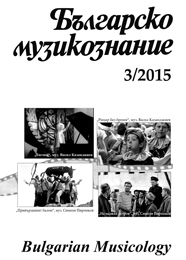Повторението в музиката и токатата
Repetition in music and toccata
Author(s): Mariyana BulevaSubject(s): Theatre, Dance, Performing Arts, Fine Arts / Performing Arts, Music
Published by: Институт за изследване на изкуствата, Българска академия на науките
Keywords: repetition; variation; difference; toccata; Pancho Vladigerov; Vassil Kazandjiev; Gilles Deleuze; singular point; modality; ostinato;
Summary/Abstract: Repetition in music is a phenomenon thoroughly studied mostly in works on musical form. The issue of repetition nevertheless is constantly arousing interest, especially in studies on minimalism, pop music and musical language. The attempts of defining repetition in music are usually associated with the law of identity. Still, post-modern philosophy provides a new vision and this paper is an attempt to rethink repetition as a difference in the vein of Gilles Deleuze. The subject of this study is the genre of toccata, which would most dynamically recreate repeatability and provide at the same time an opportunity to trace out the rethinking of musical time in various ages, from Baroque to modern days. Motion, change and repetition are interpreted as an idea, preserved over the centuries and rethought in the modern twentieth century through the urban rhythm and machine-like nature of motion. Repeatability in toccata is interpreted as a process of implementation, differentiation and individualisation, as a transition from an external to an internal repetition. The paper focuses on two pieces by Bulgarian composers: Pancho Vladigerov’s Toccata, Op. 36, No. 5. Episodes collection of keyboard works (1941) and Vassil Kazandjiev’s Toccata (1957). This choice is motivated by the fact that these are works by a teacher and his disciple with the one by Vassil Kazandjiev preserving a colourful page of their creative communication. Vladigerov’s piece highlights the periodical variance and the activation of modal traits of musical thinking. Kazandjiev’s Toccata features a variation and an asymmetry at a motif level, as well as the simultaneous action of the external (static) and the internal (dynamic) repetition in the episodes with an ostinato bass. A conclusion is reached that repetition could have quite a different meaning and be a determinant of a stylistic fixture.
Journal: Българско музикознание
- Issue Year: 2015
- Issue No: 3
- Page Range: 25-40
- Page Count: 16
- Language: Bulgarian
- Content File-PDF

